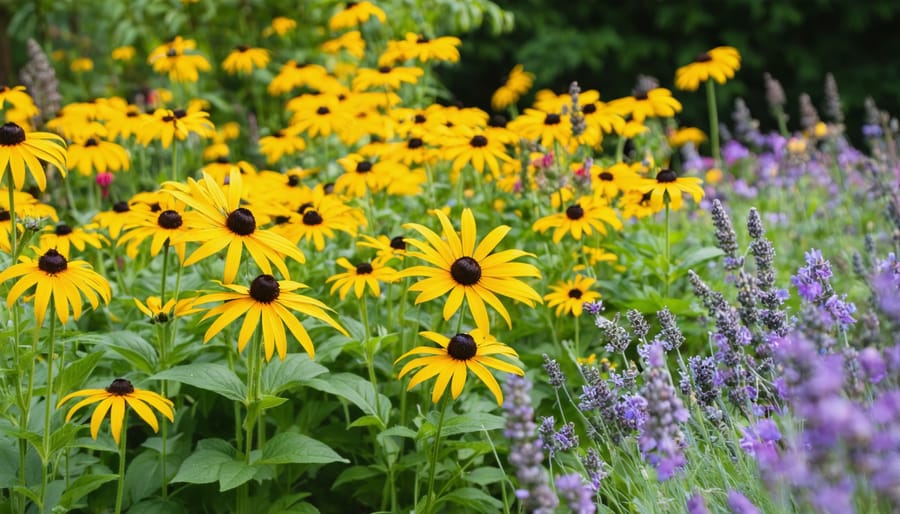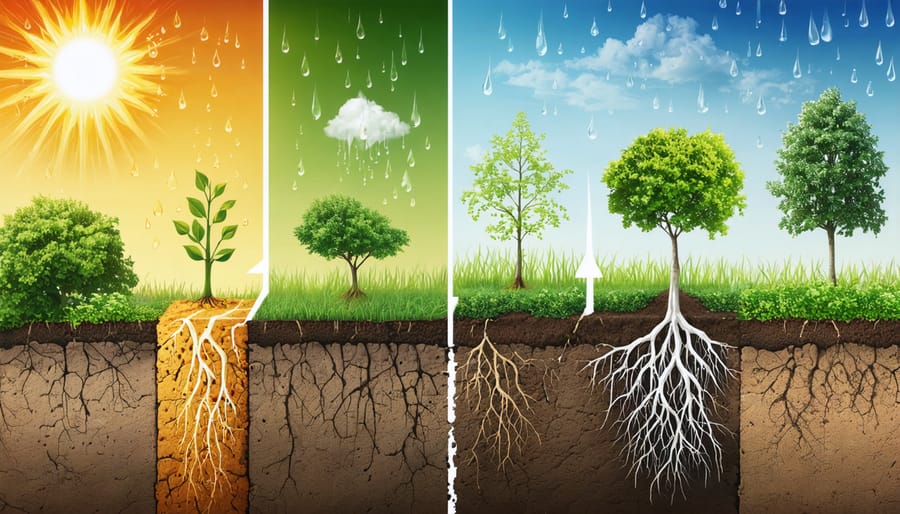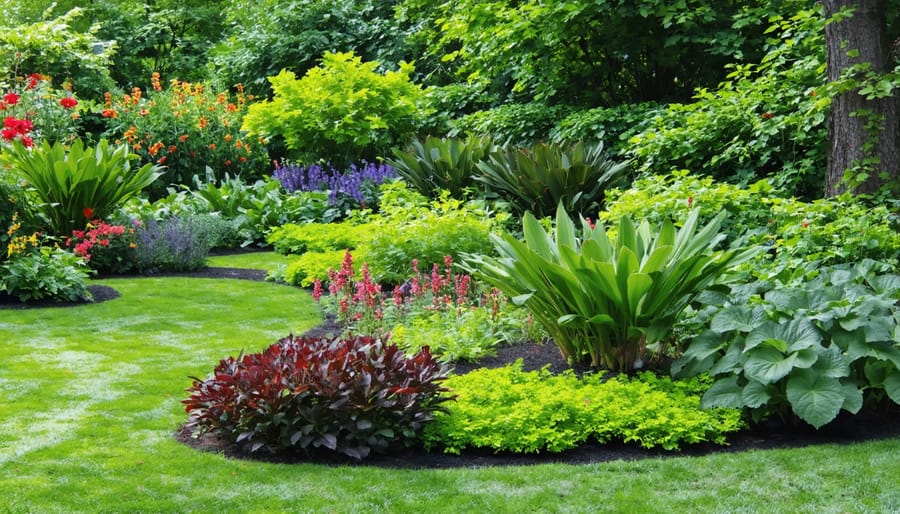Transform your garden by mastering the five fundamental climate types that shape plant success worldwide. Understanding climate zones unlocks the secret to selecting plants that not only survive but thrive in your specific environment. From the sun-drenched Mediterranean regions to humid tropical paradises, each climate type creates a unique ecosystem with distinct growing conditions. Whether you’re designing a drought-resistant xeriscape or cultivating a lush tropical oasis, identifying your climate zone serves as your roadmap to sustainable gardening success. Let’s explore these five distinct climate patterns and discover how they influence plant selection, growth cycles, and maintenance requirements – empowering you to make informed choices for your garden’s long-term vitality.

Tropical Climate Gardens
Key Characteristics of Tropical Climates
Tropical climates are nature’s most vibrant and energetic environments, characterized by consistently warm temperatures ranging from 68°F to 95°F (20°C to 35°C) throughout the year. These regions experience little seasonal variation but make up for it with distinct wet and dry periods. Rainfall is abundant, often exceeding 60 inches annually, with some areas receiving daily afternoon showers during the wet season. The combination of warm temperatures and frequent rainfall creates humidity levels that typically stay above 70%, creating that characteristic sticky feeling we associate with tropical environments. Morning dew is common, and the air feels thick and heavy, especially during summer months. These conditions create the perfect environment for lush, jungle-like growth and vibrant flowering plants that thrive in warm, moist conditions.
Best Plants for Tropical Zones
Tropical zones offer the perfect environment for lush, vibrant gardens filled with exotic plants. If you’re fortunate enough to garden in a tropical climate, you’ll have an exciting array of options to choose from. Bird of Paradise plants make stunning focal points with their dramatic orange and blue flowers, while fragrant Plumeria trees add both visual appeal and delightful scents to your garden.
For ground cover and smaller spaces, consider Chinese Evergreen or Peace Lilies, which thrive in the humid conditions typical of tropical areas. These plants are particularly easy to care for and can tolerate varying light conditions. Orchids are another excellent choice, especially varieties like Phalaenopsis and Dendrobium, which naturally grow in tropical environments.
When planning your tropical garden, remember to include some practical additions like banana trees and citrus plants, which not only look beautiful but can provide fresh fruit. For those seeking dramatic foliage, Elephant Ears (Colocasia) and Monster (Monstera deliciosa) create an impressive jungle-like atmosphere.
To ensure success with tropical plants, maintain consistent moisture levels and provide protection from intense afternoon sun. Most tropical plants prefer well-draining, rich soil and regular fertilization during the growing season. Creating layers in your garden by combining tall palms, medium-sized flowering shrubs, and ground-level plants will help achieve that lush, tropical paradise feel while maximizing your growing space.
Mediterranean Climate Success
Mediterranean Climate Features
Mediterranean climates are a gardener’s dream, with mild, wet winters and warm, dry summers that create perfect conditions for a wide variety of plants. These regions typically experience temperatures ranging from 30°F to 100°F (-1°C to 38°C), with most rainfall occurring between October and March. The summer drought period, while challenging, actually encourages many plants to develop deep root systems and drought-resistant features. You’ll notice the most pleasant weather during spring and fall, when temperatures are moderate and the landscape bursts with color. This climate pattern is relatively rare, found in only about 2% of the world’s land area, including coastal California, parts of Southern Europe, and regions of Australia. The predictable seasonal changes make it easier to plan your garden’s watering schedule and choose plants that naturally thrive in these conditions.
Thriving Mediterranean Plants
Mediterranean plants bring the sun-kissed charm of coastal Europe to any garden, offering a perfect blend of beauty and resilience. These plants have adapted to thrive in warm, dry summers and mild, wet winters, making them excellent choices for water-wise gardening.
Lavender stands as a Mediterranean garden staple, with its fragrant purple blooms and silver-grey foliage creating a stunning visual display while attracting beneficial pollinators. Rosemary, another Mediterranean hero, doubles as both an ornamental and culinary herb, requiring minimal water once established.
For structural interest, consider Italian Cypress, which adds dramatic vertical elements to your garden space. These evergreen sentinels can serve as natural privacy screens or elegant focal points. Olive trees, with their silvery leaves and gnarled trunks, bring authentic Mediterranean character while providing welcome shade.
Ground cover options like creeping thyme and sage create aromatic carpets that suppress weeds and require little maintenance. These hardy plants also release their signature scents when brushed against, adding a sensory element to your garden paths.
For successful Mediterranean plant care, ensure excellent drainage by adding plenty of grit to your soil. Most of these plants prefer full sun and actually thrive in slightly poor soil – overfeeding can lead to weak, floppy growth. Water deeply but infrequently to encourage deep root systems, which improve drought tolerance.
Continental Climate Gardens

Continental Climate Challenges
Continental climates present some of the most dramatic seasonal changes a gardener can face. Summer temperatures often soar above 85°F (29°C), while winters can plunge well below freezing, creating quite the challenge for plant survival. These regions typically experience four distinct seasons, with significant temperature swings not just between seasons, but sometimes even within a single day. Spring and fall can be particularly tricky, as late frosts or early freezes might catch gardeners off guard. The good news is that plants native to continental climates have evolved to be incredibly resilient, developing dormancy mechanisms to survive winter and robust root systems to handle temperature fluctuations. Success in continental gardens comes from embracing these natural cycles and choosing plants that can handle both extremes.
Hardy Plants for Continental Zones
Continental zones present unique challenges for gardeners, with their dramatic temperature swings and distinct seasons. Fortunately, nature has equipped certain plants with remarkable resilience to handle these conditions. Russian Sage, with its silvery foliage and purple blooms, thrives in these zones and provides stunning visual interest throughout summer and fall.
For reliable perennials, consider Black-Eyed Susans and Coneflowers, which return year after year with minimal maintenance. These native plants not only withstand harsh winters but also attract beneficial pollinators to your garden. Ornamental grasses like Feather Reed Grass and Little Bluestem offer year-round interest and exceptional drought tolerance.
When it comes to shrubs, nothing beats the hardiness of Burning Bush and Ninebark. These tough plants provide structure to your garden and beautiful fall color. For ground cover, Creeping Thyme and Sedum varieties excel in continental conditions, forming dense mats that suppress weeds while requiring little care.
Maintenance tips for continental garden success include:
– Mulching heavily in fall to protect roots from winter damage
– Watering deeply but less frequently to encourage deep root growth
– Pruning in early spring before new growth begins
– Choosing native varieties whenever possible for better adaptation
Remember to group plants with similar water needs together and provide wind protection where necessary. These hardy selections will reward you with a beautiful, low-maintenance garden that stands up to continental climate challenges.
Desert Climate Solutions
Desert Climate Characteristics
Desert climates are characterized by scorching days, chilly nights, and minimal rainfall – typically less than 10 inches annually. These arid regions experience intense sunlight and low humidity, creating challenging conditions for plant life. The soil tends to be sandy or rocky, with limited organic matter, making water retention difficult. Despite these extreme conditions, many plants have evolved remarkable adaptations to thrive here. You’ll find specialized features like waxy coatings on leaves to prevent water loss, deep root systems to access underground moisture, and modified leaves that reduce surface area. Understanding these harsh conditions is crucial for gardeners in desert regions, as it helps in selecting drought-resistant plants and implementing proper irrigation strategies to create successful desert gardens.
Desert-Adapted Plants
Desert-adapted plants are nature’s resilient survivors, perfectly equipped to thrive in arid conditions with minimal water. These remarkable plants have evolved fascinating features like waxy leaves, deep root systems, and water-storage capabilities that make them ideal choices for water-wise gardening.
Popular options include the striking Agave americana, which forms a dramatic rosette of blue-gray leaves, and the cheerful yellow-blooming Lantana, which attracts butterflies while requiring little maintenance. The Purple Sage (Salvia dorrii) adds lovely color and fragrance to desert gardens, while the compact Desert Marigold brings reliable bursts of sunshine-yellow flowers throughout the growing season.
To ensure your desert plants flourish, proper placement is crucial. Most thrive in full sun and well-draining soil, which you can achieve by incorporating sand or gravel into your garden bed. While these plants are drought-tolerant, they’ll need regular watering during their establishment period – typically the first few months after planting.
Following successful desert gardening techniques like mulching with gravel or stone helps retain moisture and keeps roots cool. Water deeply but infrequently to encourage deep root growth, and avoid fertilizing too much – desert plants actually prefer lean soil conditions.
Remember to group plants with similar water needs together, creating beautiful, low-maintenance zones that celebrate the unique beauty of desert-adapted species while conserving precious water resources.

Temperate Climate Versatility
Temperate Climate Benefits
Temperate climates offer gardeners a perfect balance of conditions for growing a diverse range of plants. With their moderate temperatures and reliable seasonal changes, these regions provide extended growing seasons and fewer extreme weather challenges. Plants experience natural dormancy periods in winter, which is essential for their long-term health, while enjoying plenty of productive growing time during spring and fall. The consistent rainfall patterns typically eliminate the need for extensive irrigation systems, making gardening more sustainable and cost-effective. Many favorite garden plants, from roses to vegetables, thrive in these conditions without requiring special protection from harsh elements. The mild winters also allow for year-round gardening activities, with opportunities to grow cool-season crops even during the colder months.
Versatile Plants for Temperate Zones
Temperate zones offer gardeners a delightful mix of conditions that support an impressive variety of plants. With distinct seasons and moderate rainfall, these regions are perfect for both ornamental and edible gardens. Many low-maintenance temperate plants can thrive here with minimal attention, making it easier for busy gardeners to maintain beautiful spaces.
Perennials like lavender, black-eyed susans, and coneflowers adapt wonderfully to temperate conditions, providing reliable blooms year after year. Deciduous trees such as maples and oaks offer stunning seasonal displays while creating beneficial shade patterns for understory plants. For vegetable enthusiasts, temperate zones support everything from cool-season crops like peas and lettuce to warm-season favorites such as tomatoes and peppers.
Success in temperate gardens often comes down to timing. Spring planting should begin after the last frost, typically in late April or early May. Fall is perfect for establishing trees and shrubs, giving roots time to develop before winter. Consider incorporating native plants, which naturally adapt to local temperature fluctuations and rainfall patterns.
To maximize your garden’s potential, layer your plantings with tall trees, medium shrubs, and ground covers. This creates diverse habitats for beneficial insects and helps maintain soil moisture. Remember to mulch well before winter to protect plant roots from freeze-thaw cycles.
Understanding your local climate is the first step toward creating a thriving garden that brings joy year after year. Each of the five climate types we’ve explored offers unique opportunities and challenges for gardeners. By matching your plant choices to your specific climate zone, you’ll save time, money, and frustration while creating a more sustainable and resilient garden.
Remember that success in gardening isn’t just about choosing the right plants – proper climate-specific soil preparation plays a crucial role too. Take time to observe your local weather patterns, test your soil, and research native plants that naturally thrive in your area.
Whether you’re gardening in a tropical paradise or a cool mountain climate, there’s a wonderful variety of plants waiting to flourish in your space. Start small, learn from your experiences, and don’t be afraid to experiment with different plant combinations that suit your climate zone. With the right knowledge and a bit of patience, you’ll soon have a garden that not only survives but thrives in perfect harmony with your local climate.




